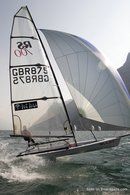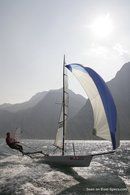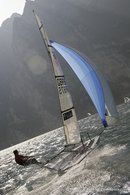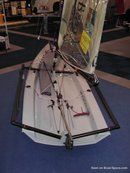RS 700
Sailboat specifications
The RS 700 is a 15’5” (4.68m) single handed skiff (dinghy) designed by Nick Peters (United Kingdom) and Alex Southon (United Kingdom). She is built since 2002 by RS Sailing (United Kingdom).
RS 700's main features
- Model
- RS 700
- Hull type
- Monohull
- Category
- Single handed skiff (dinghy)
- Sailboat builder
- Sailboat designer
- Country
- United Kingdom
- Construction
- Fiberglass reinforced epoxy:
Sandwich PVC fiberglass epoxy - First built hull
- 2002
- Last built hull
- Still in production
- Appendages
- Centerboard : daggerboard
- Helm
- Single tiller
- Rudder
- Single transom hung rudder
- Unsinkable
- No
- Trailerable
- Yes
- EC design categoryiThe CE design category indicates the ability to cope with certain weather conditions (the sailboat is designed for these conditions)
A: Wind < force 9, Waves < 10m
B: Wind < force 8, Waves < 8m
C: Wind < force 6, Waves < 4m
D: Wind < force 4, Waves < 0,5m - C
- Standard public price ex. VAT (indicative only)
- About13 500 €(2020)
RS 700's main dimensions
- Hull length
- 15’ 5”4.68 m
- Beam (width)
- 7’ 4”2.23 m
- Overall width folded
- 6’ 4”1.92 m
- Light displacement (MLC)
- 174 lb79 kg
RS 700's rig and sails
- Upwind sail area
- 138 ft²12.8 m²
- Downwind sail area
- 310 ft²28.8 m²
- Mainsail area
- 138 ft²12.8 m²
- Asymmetric spinnaker area
- 172 ft²16 m²
- Rigging type
- Sloop Marconi 7/8
- Mast configuration
- Mast foot integrated on deck
- Rotating spars
- No
- Number of levels of spreaders
- 1
- Spreaders angle
- Swept-back
- Spars construction
- Carbon fiber spars
- Standing rigging
- Continuous
RS 700's performances
- Crew
- 1
- Trapezes
- 1 set(s)
- PY (Portsmouth Yardstick) ratingiPortsmouth Yardstick is an empirical rating system allowing small sailboats (dinghies included), of different sizes and designs, to race each other fairly. Therefore, by comparing these values, we can have an indication of the relative speed of 2 boats.
- 850
- D-PN ratingiDPN is a variation of Portsmouth Yardstick used in the United States.
- 73.3
- Upwind sail area to displacementiThe ratio sail area to displacement is obtained by dividing the sail area by the boat's displaced volume to the power two-thirds.
The ratio sail area to displacement can be used to compare the relative sail plan of different sailboats no matter what their size.
Upwind: under 18 the ratio indicates a cruise oriented sailboat with limited performances especially in light wind, while over 25 it indicates a fast sailboat. - 748 ft²/T69.52 m²/T
- Downwind sail area to displacementiThe ratio sail area to displacement is obtained by dividing the sail area by the boat's displaced volume to the power two-thirds.
The ratio sail area to displacement can be used to compare the relative sail plan of different sailboats no matter what their size. - 1684 ft²/T156.43 m²/T
RS 700's auxiliary engine
- Engine(s)
- No engine
RS 700's accommodations and layout
- Cockpit
- Aft cockpit with racks
Similar sailboats that may interest you:
Sailboats
First built hull
Hull length
2001
15’ 8”4.8 m
1994
14’ 10”4.52 m
1995
13’ 1”4 m
2014
13’ 1”4 m
2010
14’ 1”4.3 m
2001
13’ 11”4.25 m
2014
13’ 10”4.2 m
1992
16’ 5”5 m
2006
14’ 2”4.34 m
2015
14’4.27 m
2009
13’ 11”4.23 m
2000
14’ 11”4.55 m
1995
15’ 2”4.64 m
2018
14’ 1”4.3 m
2017
14’ 1”4.3 m






